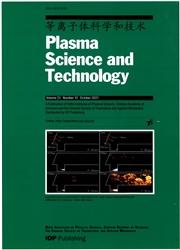Airfoil friction drag reduction based on grid-type and super-dense array plasma actuators
IF 1.8
3区 物理与天体物理
Q3 PHYSICS, FLUIDS & PLASMAS
引用次数: 0
Abstract
Abstract To improve the cruise flight performance of aircraft, two new configurations of plasma actuators (grid-type and super-dense array) were investigated to reduce the turbulent skin friction drag of a low-speed airfoil. The induced jet characteristics of the two actuators in quiescent air were diagnosed with high-speed particle image velocimetry (PIV), and their drag reduction efficiencies were examined under different operating conditions in a wind tunnel. The results showed that the grid-type plasma actuator was capable of producing a wall-normal jet array (peak magnitude: 1.07 m/s) similar to that generated in a micro-blowing technique, while the super-dense array plasma actuator created a wavy wall-parallel jet (magnitude: 0.94 m/s) due to the discrete spanwise electrostatic forces. Under a comparable electrical power consumption level, the super-dense array plasma actuator array significantly outperformed the grid-type configuration, reducing the total airfoil friction drag by approximately 22% at a free-stream velocity of 20 m/s. The magnitude of drag reduction was proportional to the dimensionless jet velocity ratio (r), and a threshold r = 0.014 existed under which little impact on airfoil drag could be discerned.基于栅格型和超密阵列等离子体作动器的翼型摩擦减阻
摘要为了提高飞机的巡航飞行性能,研究了两种新型等离子体作动器结构(栅格型和超密阵列),以减小低速翼型湍流蒙皮摩擦阻力。采用高速粒子图像测速技术(PIV)对两种致动器在静止空气中的诱导射流特性进行了诊断,并在风洞中测试了两种致动器在不同工况下的减阻效率。结果表明:栅格型等离子体致动器可产生与微吹技术类似的壁向法向射流阵列(峰值量级为1.07 m/s),而超致密阵列等离子体致动器由于其展向静电力离散,可产生波浪形壁向平行射流(峰值量级为0.94 m/s)。在相当的电力消耗水平下,超密集阵列等离子体执行器阵列的性能明显优于网格型配置,在20米/秒的自由流速度下,将总翼型摩擦阻力降低了约22%。阻力减小的幅度与无量纲射流速度比(r)成正比,存在一个阈值r = 0.014,在该阈值下翼型阻力的影响很小。
本文章由计算机程序翻译,如有差异,请以英文原文为准。
求助全文
约1分钟内获得全文
求助全文
来源期刊

Plasma Science & Technology
物理-物理:流体与等离子体
CiteScore
3.10
自引率
11.80%
发文量
3773
审稿时长
3.8 months
期刊介绍:
PST assists in advancing plasma science and technology by reporting important, novel, helpful and thought-provoking progress in this strongly multidisciplinary and interdisciplinary field, in a timely manner.
A Publication of the Institute of Plasma Physics, Chinese Academy of Sciences and the Chinese Society of Theoretical and Applied Mechanics.
 求助内容:
求助内容: 应助结果提醒方式:
应助结果提醒方式:


